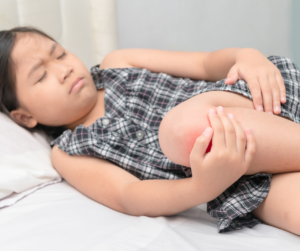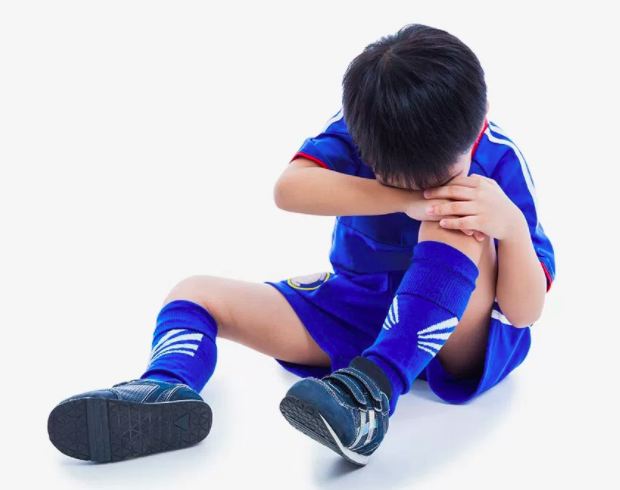
Growing pains are one of the most common pains that we see and treat in kids. While some mistake growing pains for when active kids overuse the muscles of the feet and legs to a point where they are very tired, achy and sore, this isn’t the case. Others have been told that growing pains aren’t treatable and must be waited out or just put up with – which also couldn’t be further from the truth!
Growing pains affect children aged between 8 and 16 years and get their name because they can only be experienced while they’re still growing, meaning that these pains can’t affect adults. Most often, but not always, the painful symptoms come on during a growth spurt and while it’s often in kids that are active – it’s definitely not always the case
Understanding growing pains
To understand how and why growing pains can develop, you must know that the way that all our bones get bigger as we grow is through areas in the bones called growth plates. These growth plates, medically known as apophyses, these are the areas to which your body adds new bone. As these areas are constantly in ‘development mode, they aren’t as strong as the surrounding bone, meaning that when the bones are placed under strain and tension (like during exercise!), these growth plates are more vulnerable to damage and the painful symptoms that come with them.
While the bones grow, the attaching muscles grow too
 While our bones are growing, so are our muscles – and lengthening to keep up and support them both functioning as a healthy and strong team. While our muscles and bones will ideally grow at a similar rate, at times the muscles won’t keep up and the result will be tight muscles that create a pull on the bone – particularly during running, running sports and exercise.
When this tension happens near a growth plate in the bone, the growth plate can become irritated and leave your child with pain and swelling.
While our bones are growing, so are our muscles – and lengthening to keep up and support them both functioning as a healthy and strong team. While our muscles and bones will ideally grow at a similar rate, at times the muscles won’t keep up and the result will be tight muscles that create a pull on the bone – particularly during running, running sports and exercise.
When this tension happens near a growth plate in the bone, the growth plate can become irritated and leave your child with pain and swelling.
Where do growing pains develop?
The knees, the heels and the feet are the three areas in the body where growing pains affect kids most commonly. We help children effectively manage and relieve their symptoms in all three areas, so they can get back to doing the things they love and not sit out entire sports seasons!
Knee pain – Osgood Schlatters disease
Growing pains at the knees involve the irritation of the growth plate at the top of the shin bone. The patellar tendon, which is the one that runs from the front of your thigh, across the knee and attaches to the top of the shin bone, is the one that tends to create the tight pull and affect the neighbouring growth plate.
Symptoms of Osgood Schlatters include pain and swelling when feeling below their kneecap. The symptoms are worsened by running and activities that bend the knee.
Heel pain – Sever’s disease
Growing pains at the heels occur in the very back of the heel, where the growth plate is located, next to the Achilles tendon. As the Achilles is the strongest and largest tendon in the body, if it is tight, it can place massive tension and strain on the back of the heel every time we walk and run. In adults, for some of us it even causes us to lift our heel up early off the ground or be unable to place our heels completely on the ground when the tendon is very tight.
In Sever’s, pain is felt at the back of the heel and may radiate or shoot up the leg. There may be some swelling, and your child may limp when the symptoms are in full swing, until they can get some rest.
Foot pain – Iselin’s disease
Growing pains in the feet occur on the outside-middle edge of the foot. Run your fingers along the outside edge of the foot – if you feel a bony bump around the middle, that’s where your child will feel their painful symptoms, swelling and tenderness. It is the peroneus brevis tendon that travels down the outer leg, across the outer ankle, and attaches to that bony bump (your ‘styloid’) that causes the growth plate irritation in this case. This tends to be the least common growing pain of the three – though we still see it in plenty of children every year!
Is your child experiencing pain in their feet or legs?
Pain is never a normal part of growing up – it’s always an indication that something is wrong – and in most cases, this something can be treated when it has a clear cause – which it definitely does in growing pains. Often, there are a number of factors that contribute to the increased strain from the muscles and tendons – including the structure and function of the feet and legs, footwear, the way they walk, muscle strength, and more.
We’re parents too – and we understand how important it is to get the very best care for your child – and that they can enjoy the experience too! Our podiatry team starts each appointment by understanding exactly what’s going on and causing the pain – and then puts the right care in place to both treat your child’s current symptoms and to prevent the problem from recurring in the future.
We’re here to help. Book your appointment online here or call us on 09 523 2333

Happy, healthy families is what we’re all about. This means we make looking after KIDS FEET a special priority! Kids are constantly learning, growing and exploring – it’s all part of the development process.
At times, pain can develop and it is our body’s way of saying that something isn’t quite right. By addressing this, you can alleviate growing pains and get your kids back to their happy, healthy selves! So we thought we’d shed some light on the grey area of growing pains and explain how and why growing pains occur, with reference to two common types of growing pains in the feet and legs of kids:
- Sever’s Disease – heel pain
- Osgood Schlatter Disease – pain just below the knee
Note: Growing pains can also be mistaken for active kids overusing muscles of the feet and legs to a point where they are very tired, achy and sore. The cause is very different and the treatment is too. If you’re unsure what your child is experiencing, bring them in for a check with your Podiatrist.
Growing pains – explained!
Growing pains are caused by irritation of the growth plate – the vulnerable part of your bone that is responsible for bone growth. It is also the weakest part of the bone and is weaker than the surrounding muscles, tendons and ligaments. Pain occurs when muscles pull on the area around the growth plate. Often these muscles are tight and when combined with physical activities, particularly those involving running, can really irritate the area. Because our bones and muscles may lengthen at slightly different rates during growth, we may end up with temporarily tight muscles that will trigger the pain with every step taken, and particularly with running and physical activity.
Growth plates?
It is through growth plates (medically known as epiphyseal plates) that our bones grow and lengthen. They’re located at the end of bones, including the calcaneus (heel bone) where Sever’s pain is experienced and the tibia (shin bone) where Osgood Schlatter pain is felt. These growth plates will turn into solid bone when we reach maturity and stop growing.
What are the signs and symptoms of growing pains?
Generally, growing pains can be felt as sharp pains, dull aches and/or cramps. The pain tends to worsen with exercise and any activity that’ll further irritate the growth plates. If we look at the two growing pains specifically:
- Sever’s Disease – pain is felt at the back of the heel and may radiate or shoot up the leg as it is the achilles tendon that inserts into the back of the heel where the calcaneal growth plate is located
- Osgood Schlatter Disease – pain is felt just below the kneecap in an area called the tibial tuberosity. It is the patellar tendon that inserts into this area, which spans from the quadriceps muscles at the top of the thigh, across the knee joint and into the top of the tibia (shin bone)
What should you do?
If you’ve ever heard that there’s nothing that can be done, we urge that you forget this! As with everything in the medical profession, it is cause-and-effect. This means that there is always a cause of the pain (effect). If you address and treat or prevent the cause, then there’s no reason to experience the painful effect. This is the approach that we take to growing pains, and we’ve had the privilege of helping thousands of families in Auckland settle their kids growing pain and put a smile back on their faces.
There are numerous things we can do to help settle the pain, as well as reduce the time it takes for the pains to disappear completely and for growing pains to be a thing of the past! The best options will depend on your child’s symptoms and areas of pain.
While we have briefly touched on two common areas of growing pains, these pains may occur in numerous areas in the feet and legs and the specific cause of pain in the same area can also vary from child to child. This is why it’s important to have your kids assessed by a podiatrist to understand exactly what’s going on with their lower limbs and the most effective ways that we can help.
 While our bones are growing, so are our muscles – and lengthening to keep up and support them both functioning as a healthy and strong team. While our muscles and bones will ideally grow at a similar rate, at times the muscles won’t keep up and the result will be tight muscles that create a pull on the bone – particularly during running, running sports and exercise.
When this tension happens near a growth plate in the bone, the growth plate can become irritated and leave your child with pain and swelling.
While our bones are growing, so are our muscles – and lengthening to keep up and support them both functioning as a healthy and strong team. While our muscles and bones will ideally grow at a similar rate, at times the muscles won’t keep up and the result will be tight muscles that create a pull on the bone – particularly during running, running sports and exercise.
When this tension happens near a growth plate in the bone, the growth plate can become irritated and leave your child with pain and swelling.

